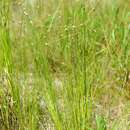Description
provided by eFloras
Perennial to more than 1 m, forming tussocks. Rhizome short, woody, emitting tillers. Stem 0.8-3.5 mm diam., smooth, terete or obtusely, occasionally sharply trigonous and scabrous above, greyish green. Leaves nearly completely reduced to c. equalling stem; sheaths 3-15 cm, from rather soft, grey brown to rigid, reddish brown and glossy, scarious side strongly nerved, mouth oblique; ligule 0 or incomplete; blades canaliculate, greyish green, adaxial surface reduced, narrow, margins scabrous, apex flat, obtuse, scabrous. Inflorescence of 1 to more than 100 congested globose heads of spikes; bracts 1-3 leaf-like, lowest 1-20 cm, mostly erect, others when present shorter; primary branches up to more than 10 cm; secondary branches up to 30 mm; heads of spikes 3-15 mm diam., formed by 6-40 spikes tightly pressed together, bracts and prophylls glume-like. Spikes 1.5-4 x 1-2 mm, ovoid or almost globose, with 10-30 glumes, 1-1.7 mm, cymbiform, keeled, mucronate, apical part barbed, sides with 2-3 nerves, brown or reddish brown, margins narrowly scarious, ciliate; anthers 1-1.6 mm. Nut 1-1.3 x 0.5-0.7 mm, ellipsoid or obovoid, trigonous, plano-convex, edges rather sharp, apex mucronate, sides finely reticulate with black areole, almost smooth, glossy.
- license
- cc-by-nc-sa-3.0
- copyright
- Missouri Botanical Garden, 4344 Shaw Boulevard, St. Louis, MO, 63110 USA
Distribution
provided by eFloras
Distribution: From S England and Canary Islands to Pakistan and SW Siberia; casual in N America.
- license
- cc-by-nc-sa-3.0
- copyright
- Missouri Botanical Garden, 4344 Shaw Boulevard, St. Louis, MO, 63110 USA
Synonym
provided by eFloras
Scirpus holoschoenus L., Sp. Pl. 1: 49. 1753; C. B. Clarke in Hook.f., l.c. 655; R. R. Stewart, l.c. 101.
- license
- cc-by-nc-sa-3.0
- copyright
- Missouri Botanical Garden, 4344 Shaw Boulevard, St. Louis, MO, 63110 USA
Scirpoides holoschoenus: Brief Summary
provided by wikipedia EN
Scirpoides holoschoenus is a species of perennial sedge in the family Cyperaceae, commonly called the roundhead bulrush. It has a self-supporting growth form and simple, broad leaves. They are associated with freshwater habitat. Individuals can grow to 0.75 m.
- license
- cc-by-sa-3.0
- copyright
- Wikipedia authors and editors


![]() This article incorporates text from a free content work. Licensed under CC0 (license statement/permission). Text taken from Scirpus holoschoenus, . Encyclopedia of Life.
This article incorporates text from a free content work. Licensed under CC0 (license statement/permission). Text taken from Scirpus holoschoenus, . Encyclopedia of Life.